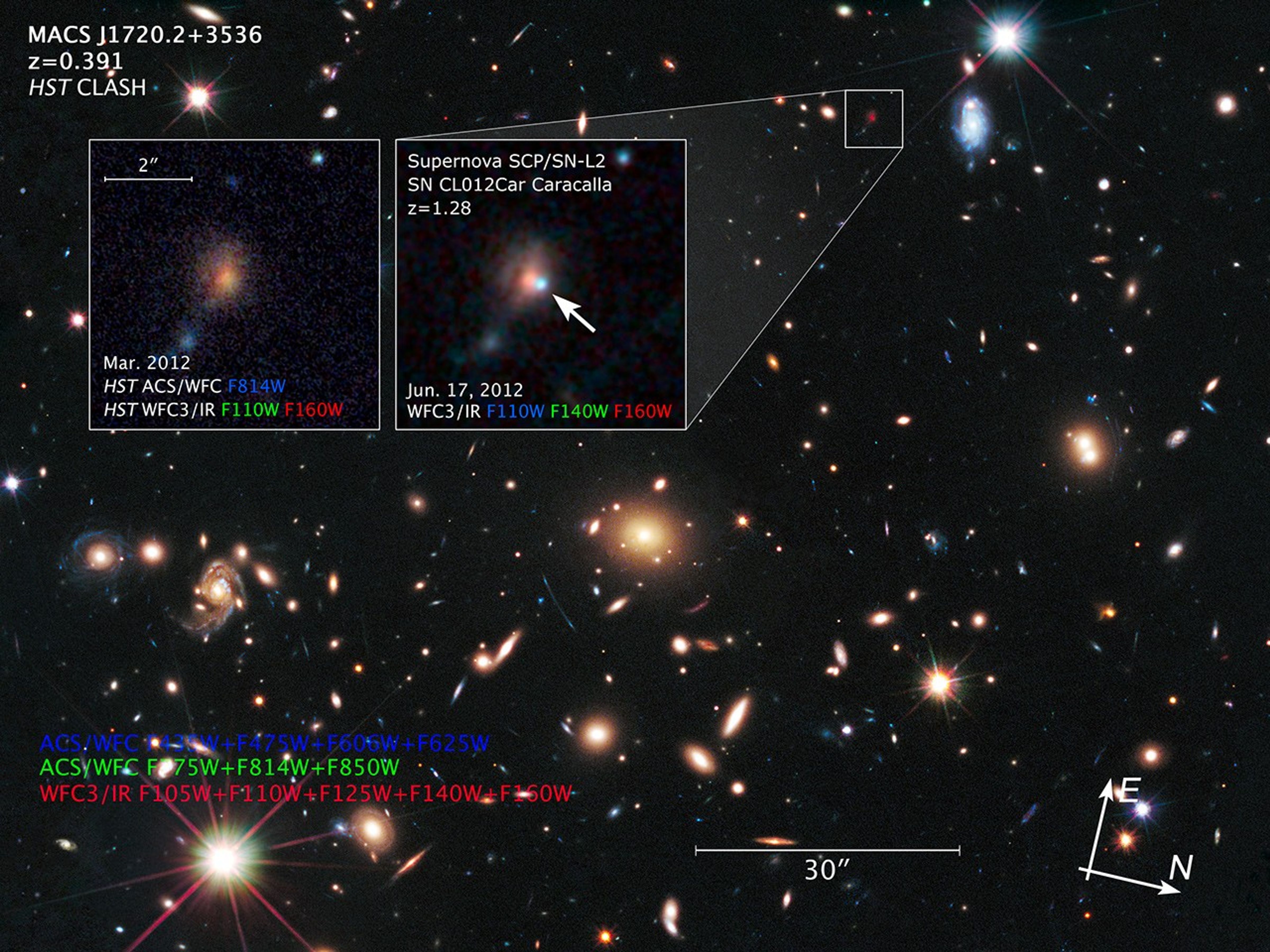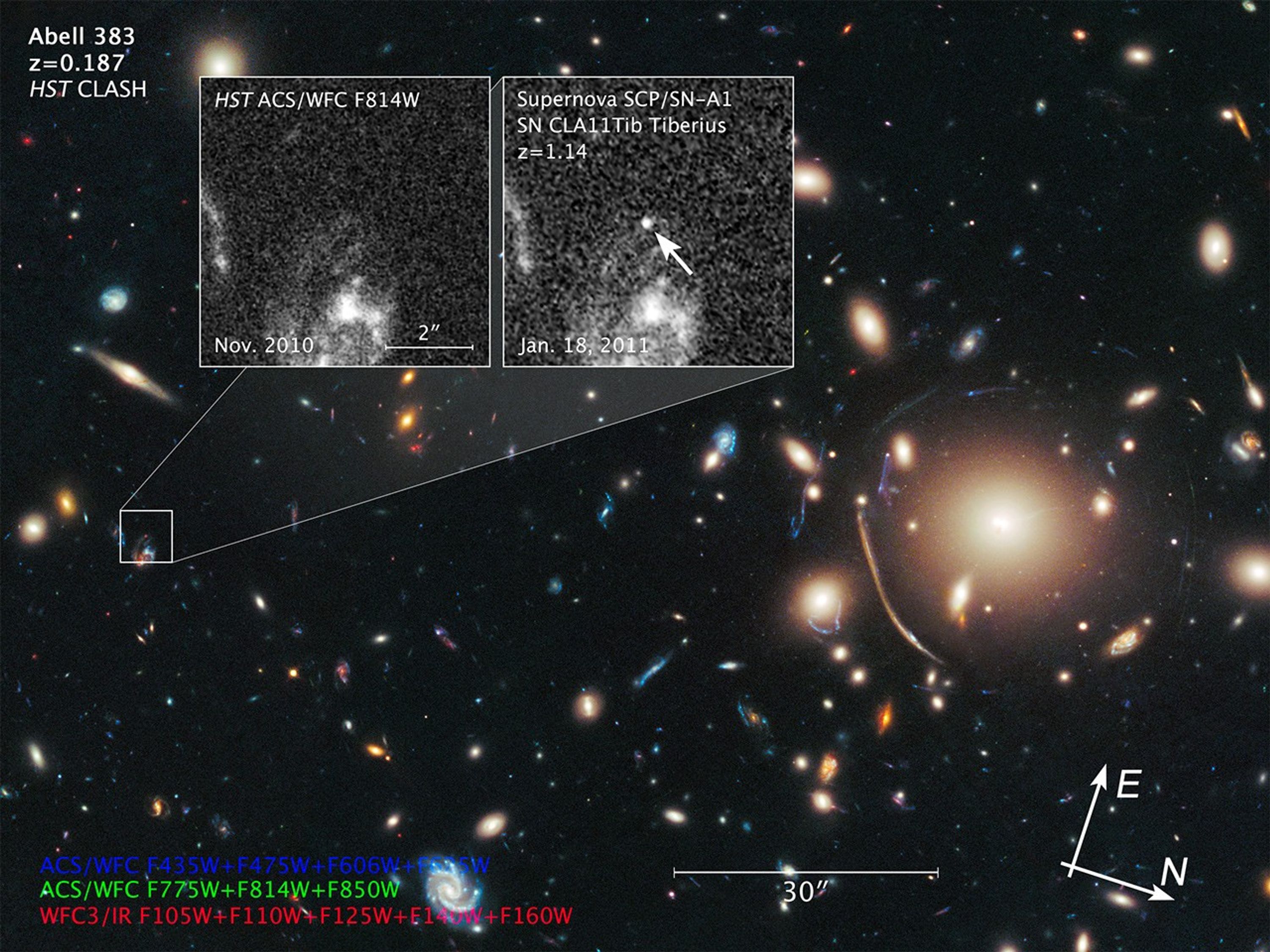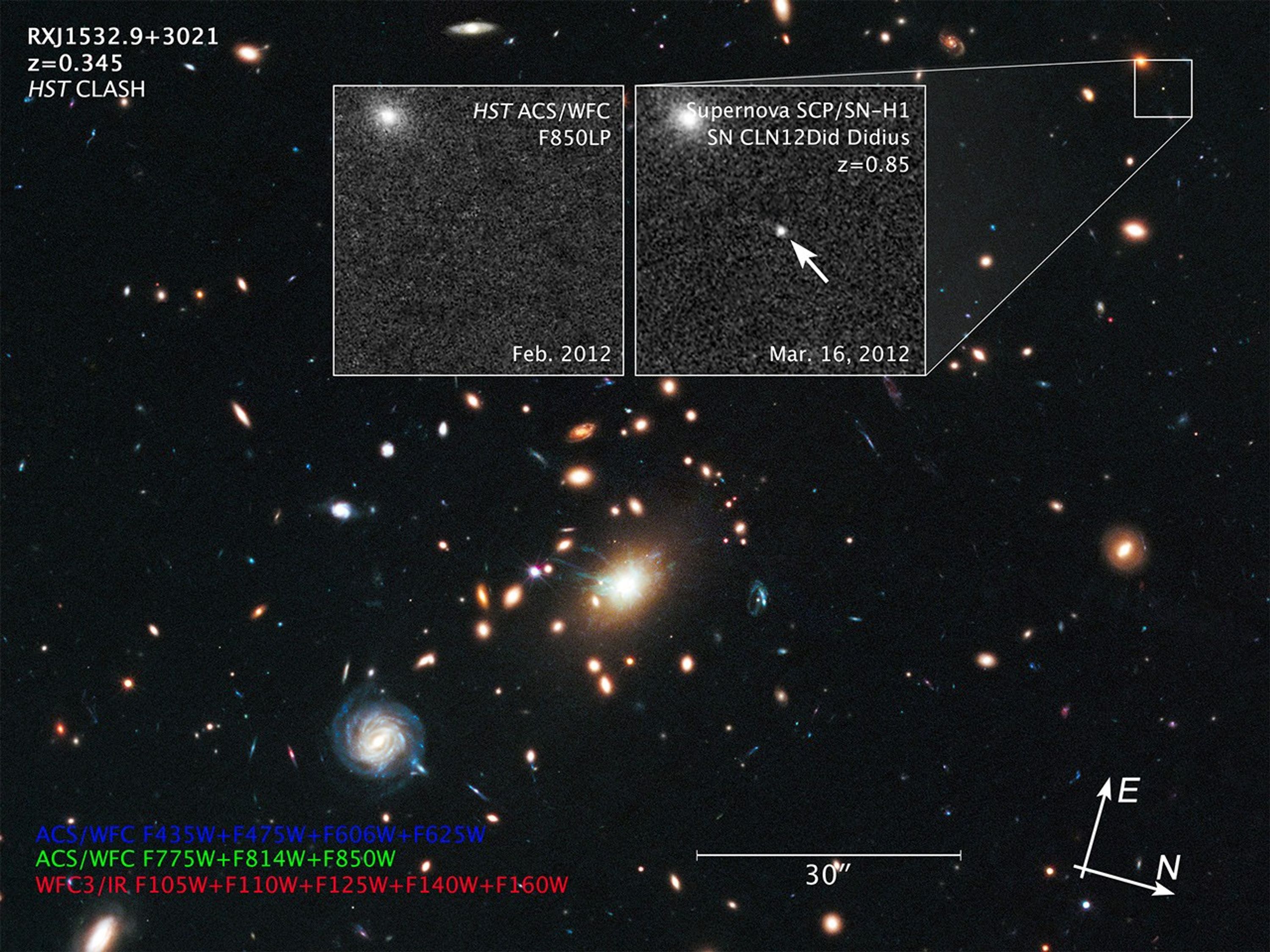1 min read
Remote Supernova Magnified by Massive Galaxy Cluster MACSJ1720
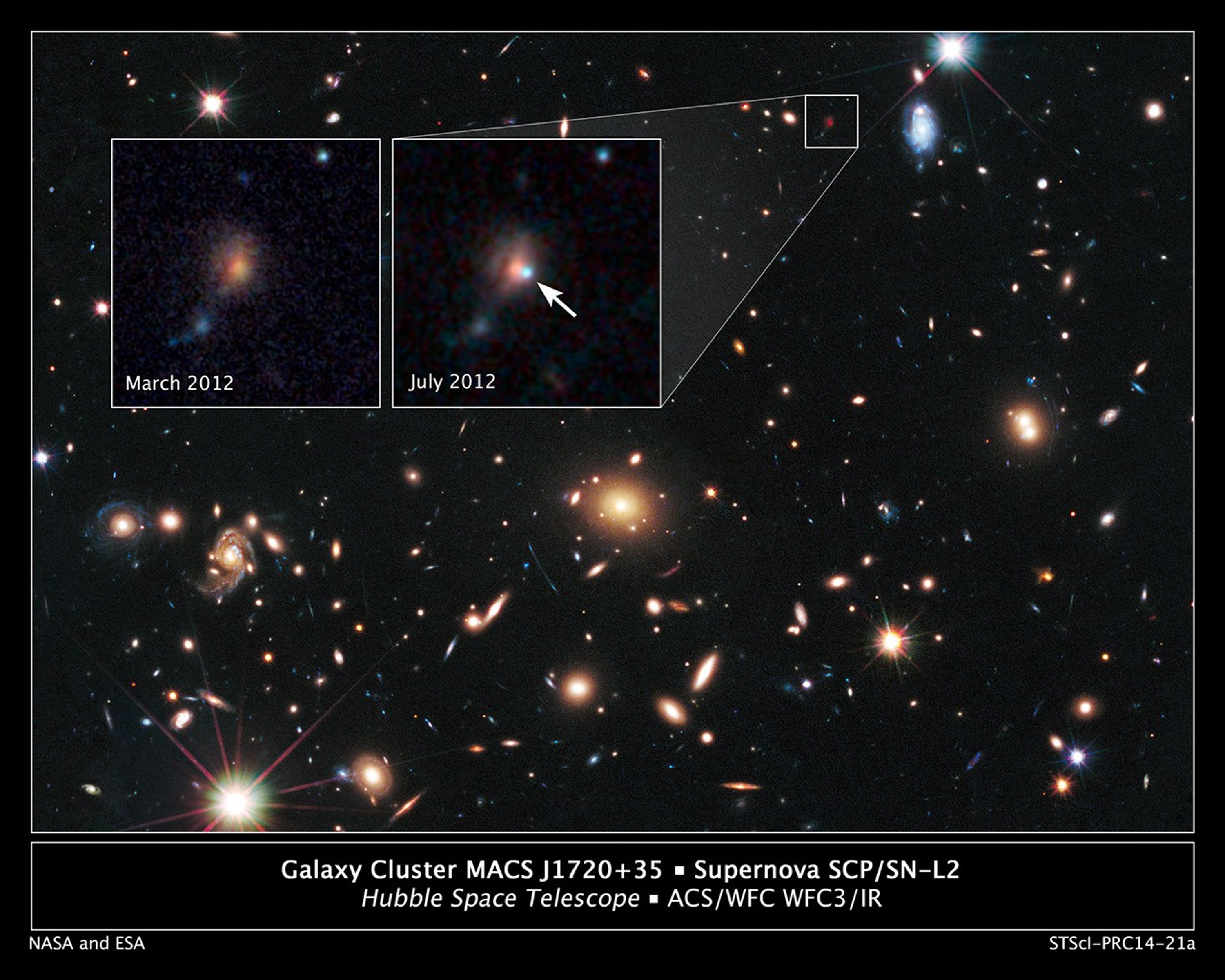
The heart of a vast cluster of galaxies called MACS J1720+35 is shown in this image, taken in visible and near-infrared light by NASA's Hubble Space Telescope.
The galaxy cluster is so massive that its gravity distorts, brightens, and magnifies light from more-distant objects behind it, an effect called gravitational lensing. The small white box at upper right marks the location of an exploding star called a supernova, located behind the cluster.
An enlarged view of the supernova, catalogued as SCP/SN-L2, is shown in the inset image at top right, taken during July 2012. An arrow marks the location of the supernova, which resides near the bright core of the host galaxy. The supernova is seen as it appeared 7.7 billion years ago. The image was taken in near-infrared light with Hubble's Wide Field Camera 3.
The inset image at top left, taken in March 2012, shows the same region before the supernova blast. This image underscores the transient nature of exploding stars. Astronomers combined observations taken in visible and near-infrared light with Hubble's Advanced Camera for Surveys and Wide Field Camera 3 to make the image. The supernova is a member of a special class of exploding star called Type Ia, prized by astronomers because it provides a consistent level of peak brightness that makes it reliable for making distance estimates.
Finding a gravitationally lensed Type Ia supernova gives astronomers a unique opportunity to check the optical "prescription" of the foreground lensing cluster. The supernova is one of three exploding stars discovered in the Cluster Lensing And Supernova survey with Hubble (CLASH), and was followed up as part of a Supernova Cosmology Project HST program. CLASH is a Hubble census that probed the distribution of dark matter in 25 galaxy clusters. Dark matter cannot be seen directly but is believed to make up most of the universe's matter.
The image of the galaxy cluster was taken between March and June 2012 by Hubble's Wide Field Camera 3 and Advanced Camera for Surveys.
About the Object
- R.A. PositionR.A. PositionRight ascension – analogous to longitude – is one component of an object's position.17h 20m 16.8s
- Dec. PositionDec. PositionDeclination – analogous to latitude – is one component of an object's position.35° 36' 25.99"
About the Data
- Data DescriptionData DescriptionProposal: A description of the observations, their scientific justification, and the links to the data available in the science archive.
Science Team: The astronomers who planned the observations and analyzed the data. "PI" refers to the Principal Investigator.The image was created from Hubble data from proposal 12445 (PI: M. Postman, STScI) - InstrumentInstrumentThe science instrument used to produce the data.HST>ACS/WFC and HST>WFC3/IR
- Exposure DatesExposure DatesThe date(s) that the telescope made its observations and the total exposure time.March - June, 2012
- FiltersFiltersThe camera filters that were used in the science observations.Galaxy cluster image: ACS/WFC: F435W, F475W, F606W, F625W, F775W, F814W, and F850W WFC3/IR: F105W, F110W, F125W, F140W, and F160W March 2012 inset image: ACS/WFC: F814W WFC3/IR: F110W and F160W June 2012 inset image: WFC3/IR: F110W, F140W, and F160W
- Object NameObject NameA name or catalog number that astronomers use to identify an astronomical object.MACSJ1720, MACS J1720.2+3536, Supernova SCP/SN-L2, SN CL012Car, Caracalla
- Object DescriptionObject DescriptionThe type of astronomical object.Galaxy Cluster and Gravitationally Lensed Supernovae
- Release DateMay 1, 2014
- Science ReleaseHubble Astronomers Check the Prescription of a Cosmic Lens
- CreditNASA, ESA, S. Perlmutter (UC Berkeley, LBNL), A. Koekemoer (STScI), M. Postman (STScI), A. Riess (STScI/JHU), J. Nordin (LBNL, UC Berkeley), D. Rubin (Florida State University), and C. McCully (Rutgers University); Photo Credit: NASA, ESA, S. Perlmutter (UC Berkeley, LBNL), A. Koekemoer (STScI), M. Postman (STScI), A. Riess (STScI/JHU), J. Nordin (LBNL, UC Berkeley), D. Rubin (Florida State University), and C. McCully (Rutgers University) Science Credit: NASA, ESA, the Supernova Cosmology Project [J. Nordin (E.O. Lawrence Berkeley National Lab/University of California, Berkeley), D. Rubin (Florida State University), J. Richard (University of Lyon), E. Rykoff (Kavli Institute for Particle Astrophysics and Cosmology, SLAC National Accelerator Laboratory), G. Aldering (E.O. Lawrence Berkeley National Lab), R. Amanullah (The Oskar Klein Centre, Stockholm University), H. Atek (École Polytechnique Fédérale de Lausanne), K. Barbary (Argonne National Laboratory), S. Deustua (STScI), H. Fakhouri (E.O. Lawrence Berkeley National Lab/University of California, Berkeley), A. Fruchter (STScI), A. Goobar (The Oskar Klein Centre, Stockholm University), I. Hook (University of Oxford/INAF-Osservatorio Astronomico di Roma), E. Hsiao (Carnegie Observatories, Chile), X. Huang (University of California, Berkeley/University of San Francisco) J.-P. Kneib (École Polytechnique Fédérale de Lausanne/Laboratoire d'Astrophysique de Marseille), C. Lidman (Australian Astronomical Observatory), J. Meyers (Stanford University), S. Perlmutter and C. Saunders (E.O. Lawrence Berkeley National Lab/University of California, Berkeley), A. Spadafora (E.O. Lawrence Berkeley National Lab), and N. Suzuki (Kavli Institute for the Physics and Mathematics of the Universe, University of Tokyo)], and the CLASH Team [B. Patel, C. McCully, and S. Jha (Rutgers University), S. Rodney and D. Jones (Johns Hopkins University), O. Graur (Johns Hopkins University/Tel Aviv University/American Museum of Natural History/New York University), J. Merten (Jet Propulsion Laboratory), A. Zitrin (California Institute of Technology), A. Riess (STScI/Johns Hopkins University), T. Matheson (National Optical Astronomy Observatory), M. Sako (University of Pennsylvania), T. W.-S. Holoien (Rutgers University), M. Postman and D. Coe (STScI), M. Bartelmann (University of Heidelberg), I. Balestra (INAF-Osservatorio Astronomico di Trieste/INAF- Osservatorio Astronomico di Capodimonte), N. Benitez (Instituto de Astrofisica de Andalucia), R. Bouwens (Leiden Observatory), L. Bradley (STScI), T. Broadhurst (University of the Basque Country), S.B. Cenko (Goddard Space Flight Center/University of California, Berkeley), M. Donahue (Michigan State University), A. Filippenko (University of California, Berkeley), H. Ford (Johns Hopkins University), P. Garnavich (University of Notre Dame), C. Grillo (Niels Bohr Institute), L. Infante (Pontificia Universidad Catolica de Chile), S. Jouvel (Institut de Ciències de l'Espai), D. Kelson (Observatories of the Carnegie Institution of Washington), A. Koekemoer (STScI), O. Lahav (University College, London), D. Lemze (Johns Hopkins University), D. Maoz (Tel Aviv University), E. Medezinski (Johns Hopkins University), P. Melchior (Ohio State University), M. Meneghetti (INAF-Osservatorio Astronomico di Bologna), A. Molino (Instituto de Astrofisica de Andalucia), J. Moustakas (Siena College), M. Nonino (INAF-Osservatorio Astronomico di Trieste), P. Rosati (Universita di Ferrara/ESO), S. Seitz (Universitats-Sternwarte), L. Strolger (STScI), K. Umetsu (Academia Sinica), and W. Zheng (Johns Hopkins University)]

Galaxy cluster image: Blue: F435W + F475W + F606W + F625W Green: F775W + F814W + F850W Red: F105W + F110W + F125W + F140W + F160W March 2012 inset image: Blue: F814W Green: F110W Red: F160W June 2012 inset image: Blue: F110W Green: F140W Red: F160W

Related Images & Videos
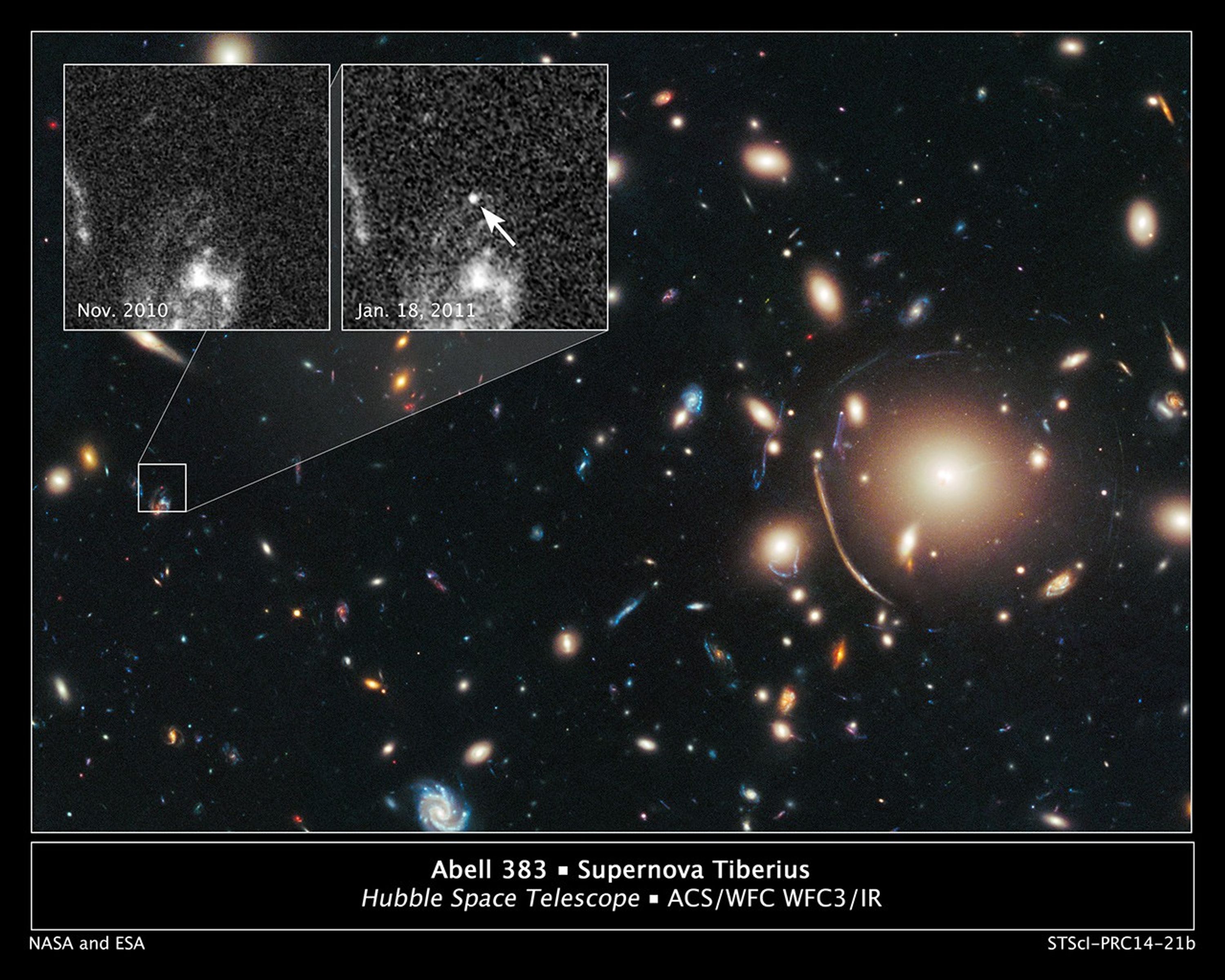
Remote Supernova Magnified by Massive Galaxy Cluster Abell 383
The heart of a vast cluster of galaxies called Abell 383 is shown in this image, taken in visible and near-infrared light by NASA's Hubble Space Telescope. The galaxy cluster is so massive that its gravity distorts, brightens, and magnifies light from more-distant objects behind...
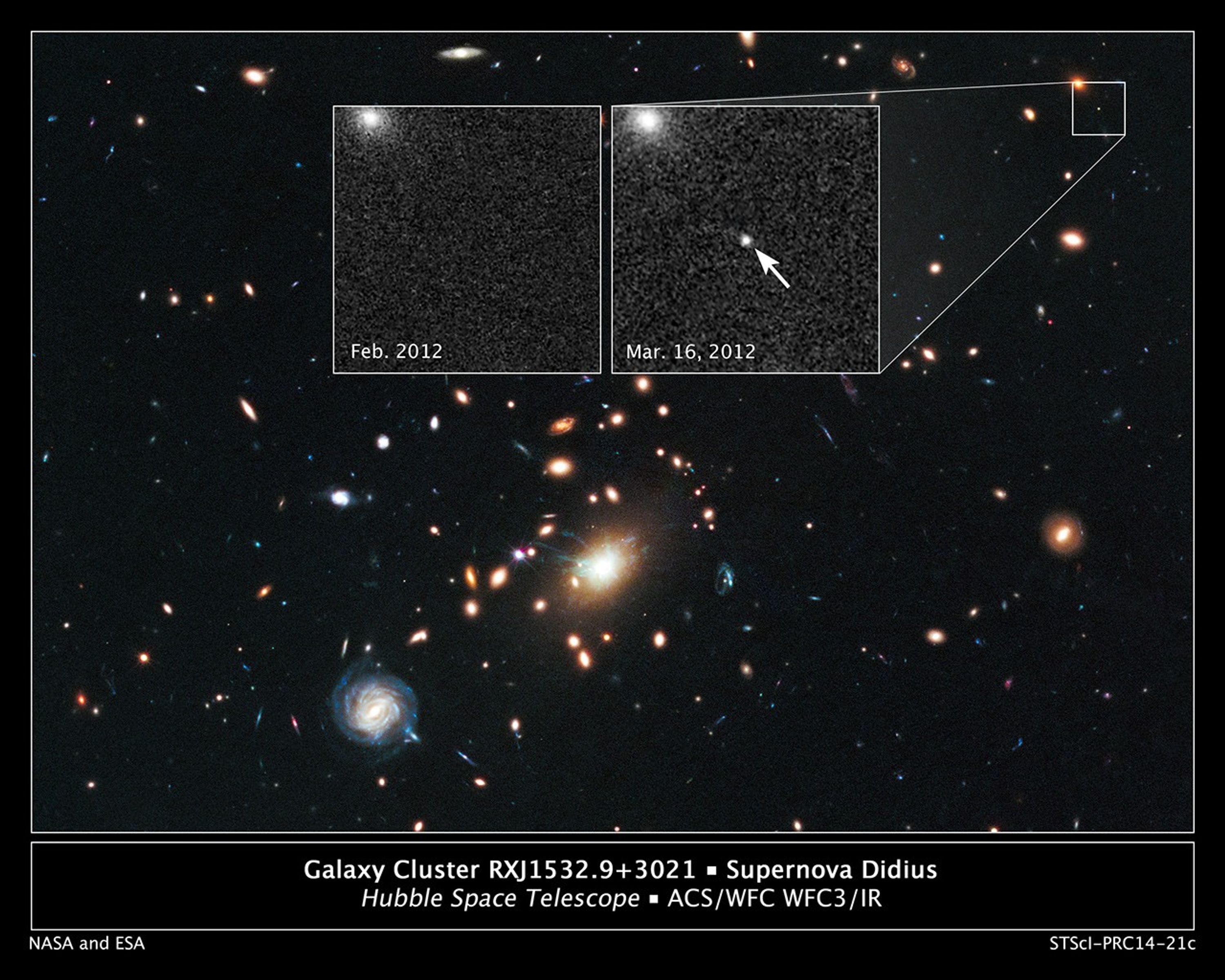
Remote Supernova Magnified by Massive Galaxy Cluster RXJ1532.9+3021
The heart of a vast cluster of galaxies called RXJ1532.9+3021 is shown in this image, taken in visible and near-infrared light by NASA's Hubble Space Telescope. The galaxy cluster is so massive that its gravity distorts, brightens, and magnifies light from more-distant objects...
Share
Details
Claire Andreoli
NASA’s Goddard Space Flight Center
Greenbelt, Maryland
claire.andreoli@nasa.gov




































